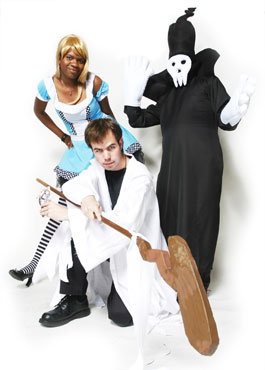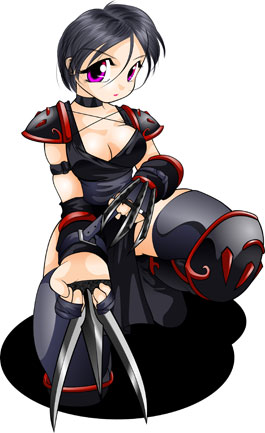home | metro santa cruz index | feature story

Geek Chic
At this weekend's convention, cosplayers take anime love to new heights of nerditude
By Curtis Cartier
IN THE BACK of Robbie Pleasant's closet, behind a few wrinkled T-shirts and a couple pairs of pants, are rows and rows of costumes. Among them is a black-and-silver collared robe modeled after "Manjoume" from the anime series Yu-Gi-Oh GX. There's also a white flowing martial-arts-type gi like the one "Aizen" wears in Bleach and a tattered wizardly gown famously donned by "Nagi" in Mahou Sensei Negima!
In another corner of his cluttered room, a pile of weapons is stacked: a long crooked staff, a wooden katana blade and a pair of small swords crossed in an "X," each with its corresponding attire hanging proudly nearby. On his walls are posters of big-eyed heroes and heroines; on his desk, stacks of DVDs and video games, each colorfully illustrated with characters that look like they shop at the same stores he does.
And though it would be easy to write him off as a run-of-the-mill Japanimation geek, that would miss the mark. Pleasant is a cosplayer—an anime fan who takes his love of the Japanese art and cranks the nerd dial up to dizzying heights by creating costumes and dressing the part of his favorite characters. And for four days at the FanimeCon anime convention at the San Jose Convention Center this week, his ilk will reign supreme.
"I started in 2004 or 2005 when a friend suggested I go to an anime convention, and I said, 'Yes, but I want to cosplay,"' says the 20-year-old UC–Santa Cruz literature major matter-of-factly. "Now I go to four or five conventions per year. I usually don't have enough money to buy the fancy costumes, so I try and construct mine with materials I acquire at thrift stores. My grandma helps sew some of the harder ones. She's incredible."
Cosplaying—or, as it's known in Japanese (and to the more hardcore fans), kosupure—represents a fervent subculture of anime fanatics that travel to conventions like FanimeCon and Anime Expo in Los Angeles, chat on message boards like cosplay.com and meet up at parks and coffee shops around the world dressed like everything from twinkly-eyed schoolgirls to multitentacled beasts.
Their source material is most often anime titles, manga (comic book) series and Japanese fashion trends, though video game heroes and American animation characters also find traction in certain circles.
At FanimeCon, which has been held every year since 1994 and drew 15,000 fans last year, the motto is "By Fans, For Fans." That might as well be "By Cosplayers, For Cosplayers," because for folks like Pleasant and others like Jerry Pang, who's coming dressed as "Russell," the plump Asian Cub Scout from Disney Pixar's Up, the anime art itself takes a back seat to the elaborate costumes created in tribute to it.
"Cosplaying is its own universe," say Pang. "It's essentially representing something you have viewed on mainstream media and emulating it. Five to seven years ago it was really underground. Now it's pretty widespread. It's just an excuse to hang out with friends who are into the same things you are."
Nerds and Nerdettes
While other geek mainstays like Dungeons and Dragons or Magic: The Gathering exist suspended in a thick solution of nearly pure testosterone, cosplaying manages to attract a sizable number of ladies. In anime films and comics, female characters often find leading roles as deadly assassins, seductive temptresses and powerful matriarchs. And if the powerful roles weren't enough, the female characters are also often dressed like they're on their way to a beachside bondage party, giving a gal with some assets to showcase plenty of options. And for the girls that would rather go as a hulking hero or the guys who long to wear miniskirts and knee-highs, "crossplaying" is a common and accepted practice.
Kai Gault, a 21-year-old San Jose resident who moved from Michigan last year and starts at West Valley College this fall, has been cosplaying since 2007.
"I remember seeing cosplayers in magazines and saying, 'Man, I want to do that,'" says the young woman, who's going to FanimeCon as "Tall Alice" from Alice in Wonderland and also as "Revy" from the anime series Black Lagoon. "I think of it as an expression of my fandom. Also, being able to dress up and act differently, it's kind of an escape from reality.
"A common misconception is that we're just nerds. Yeah, you have to be a nerd, but most of us do have jobs and lives and don't live in our mom's basement."
The more crafty cosplayers like Gault and Pleasant (or rather, Pleasant's grandma) make their own costumes from items found at stores like Goodwill, Savers and The Home Depot. Others buy their costumes from sites like qqcosplay.com, where hundreds of precisely made anime costumes are available for anywhere from $75 to $1,000. A sales agent from the Chinese-based company says they ship about 200 costumes per month to fans around the world and that characters from Bleach, Naruto and Kingdom Hearts are the most common items.
When Pleasant, Gault, Pang and others get to FanimeCon, one of the first orders of business will be seeking out other fans who dressed as characters in the same anime title. After that, however, all that's left is the partying.
"Cosplayers can get crazy," says Pleasant as he readjusts his glasses and hangs his Aizen costume back in his closet. "We certainly know how to have a good time."
FANIMECON geeks out Friday–Monday, May 28–31, at the San Jose Convention Center, 150 W. San Carlos St., San Jose. Registration is $55 per person and includes all four days. For more info and to register visit www.fanime.com

Art byYoung Wang
Anime's X-Games
NIME is clearly the future of animation. Japanese animation is an economic powerhouse—a $4 billion industry—and cultural fire hose that's already shaped Asian pop culture and is now in the middle of shaping our own. Our high school students don't need a dictionary to understand the word otaku, a once-negative term meaning "shut-in addict," now worn as a badge of honor like "nerd."
At night at FanimeCon, adults-only cartoons come out, including a screening of some examples of the hentai porn subgenre, which is like a cuter version of American porn—popular, indefensible, sometimes copyright-stretching.
Elsewhere, there's some gaming: a group Japanese spelling-bee game in which players make male cartoon figures (bishonen, they're called—meaning, essentially, the young David Bowie type) give up their Armani-oid wardrobes bit by bit. Anime has what U.S. animation lacks in its category of yaoi and yuri—male/male and female/female love stories, scripted with a soap-opera elaboration unmatched in American animated films.
Yaoi is an acronym meant to advertise the harmlessness of the material: Yama nashi, ochi nashi, imi nashi (no climax, no point, no meaning), in other words, not hentai on the whole, with unrequited love and hurt feelings. The female audience for yaoi (and it's almost all female) gets to see the common unthreatening boy love we usually see in Disney programs, only in yaoi it's taken to the next step.
Yuri is the other side of the spectrum, presumably enjoyed by some males. If you like wading through verbal labyrinths, try finding even a simple summing-up of the plot of the yuri manga-turned-anime Strawberry Panic, filmed in 26 episodes by Madhouse Studios. The Sapphic (but again, never very explicit) conduct at the three separate girls' schools in this series is more complicated than the who's who at Hogwarts.
The idea of erotic animation is loaded, because it's always assumed that the key audience for animation is sheltered children, plus it makes good copy. The point is that anime doesn't have to be either Pikachu or battle robots. Of course, you don't become a multibillion-dollar industry without leaving some toxic waste around.
The visiting Anime Hell "otakalypse" show at Fanime will offer some of the worst of the worst; bad animation is always prized by hipsters. Still, a tradition that offers up Princess Mononoke, Barefoot Jen, Paprika, and Ghost in the Shell still has its best years ahead of it.
Richard von Busack
Send letters to the editor here.
|
|
|
|
|
|